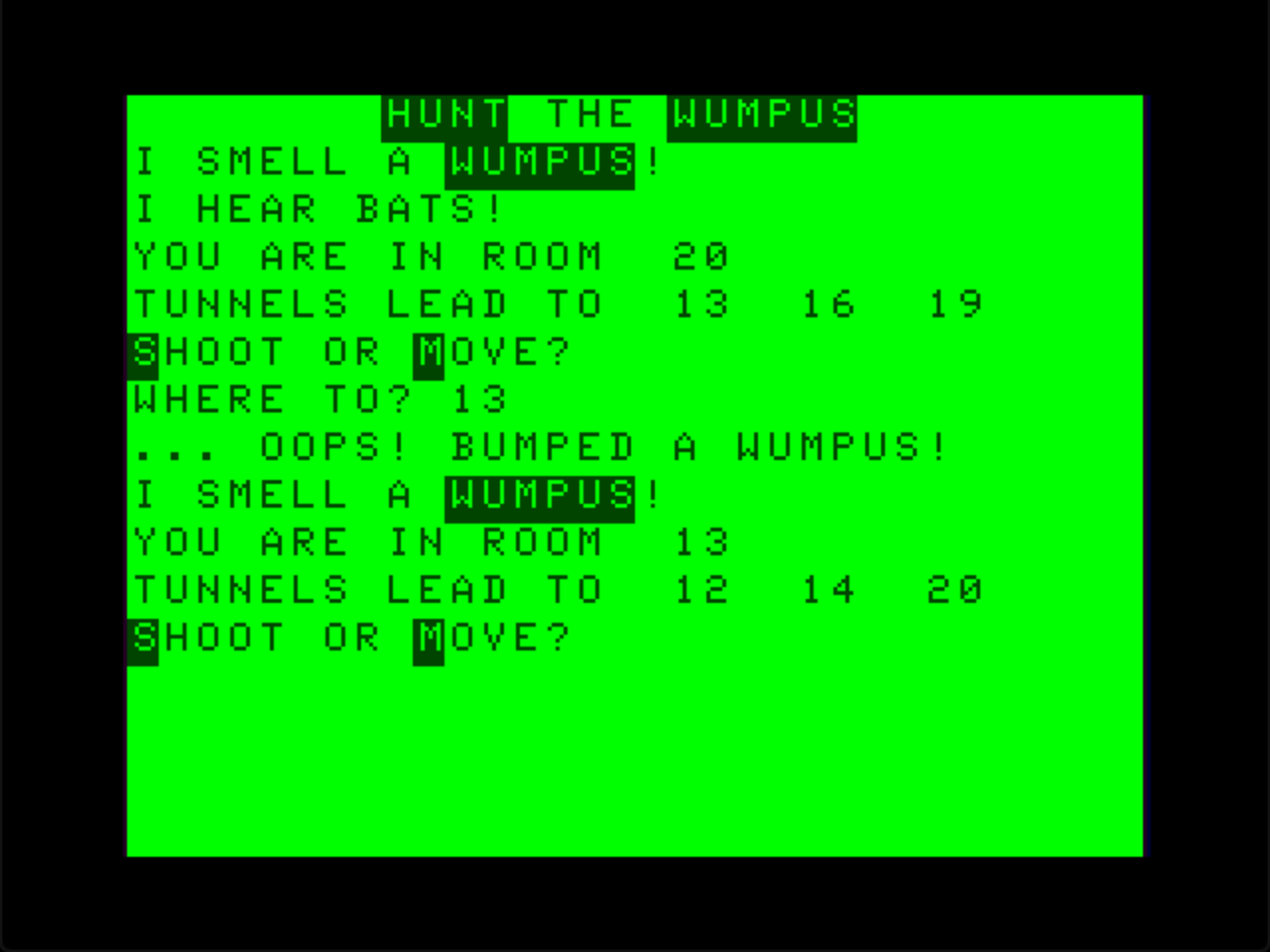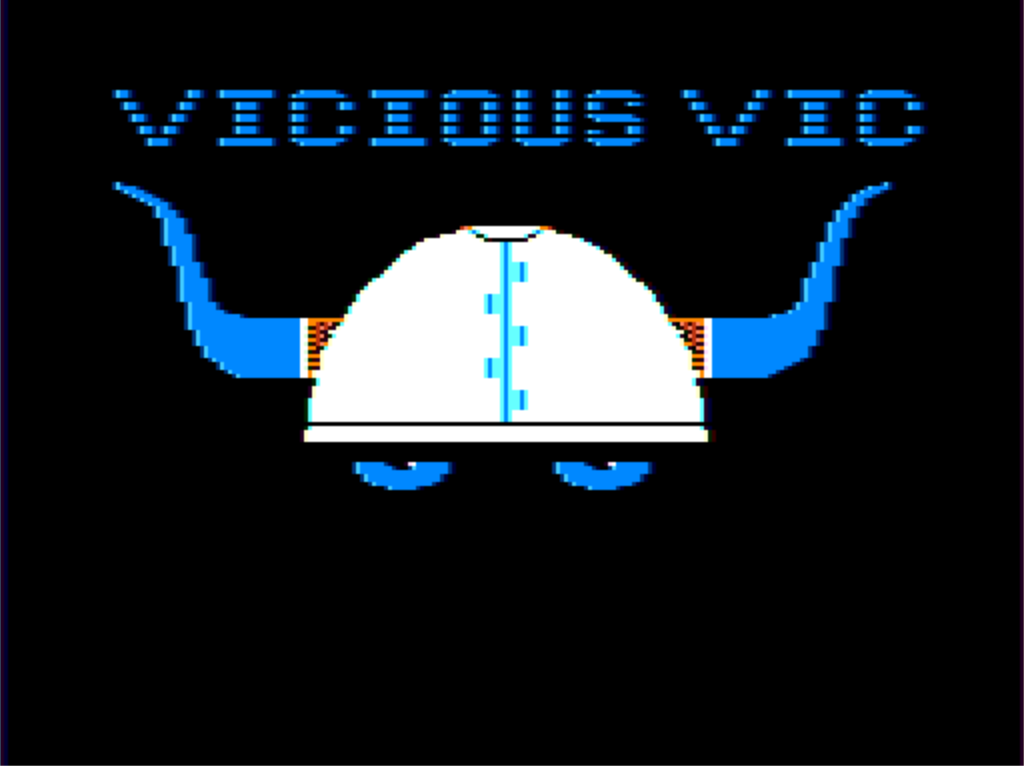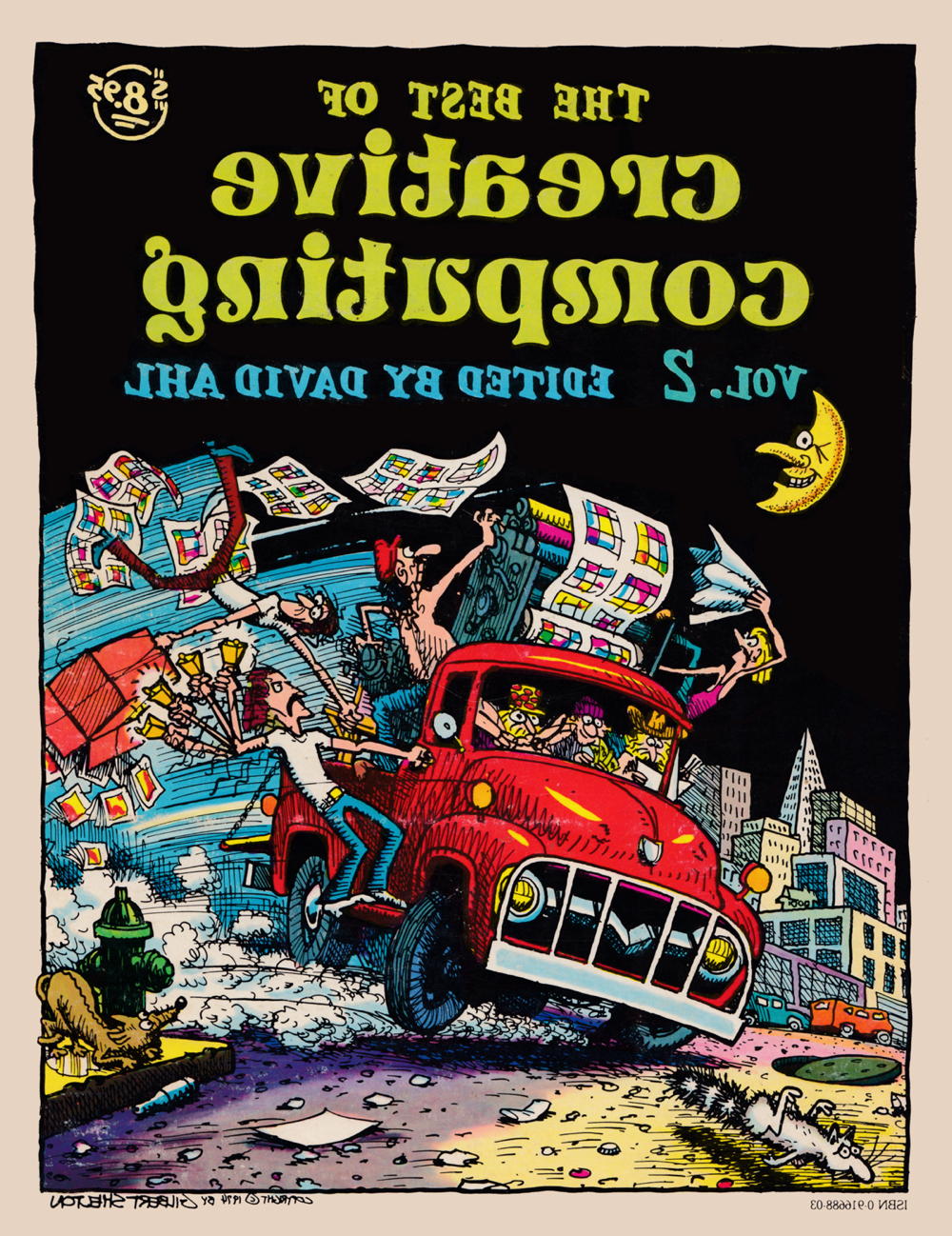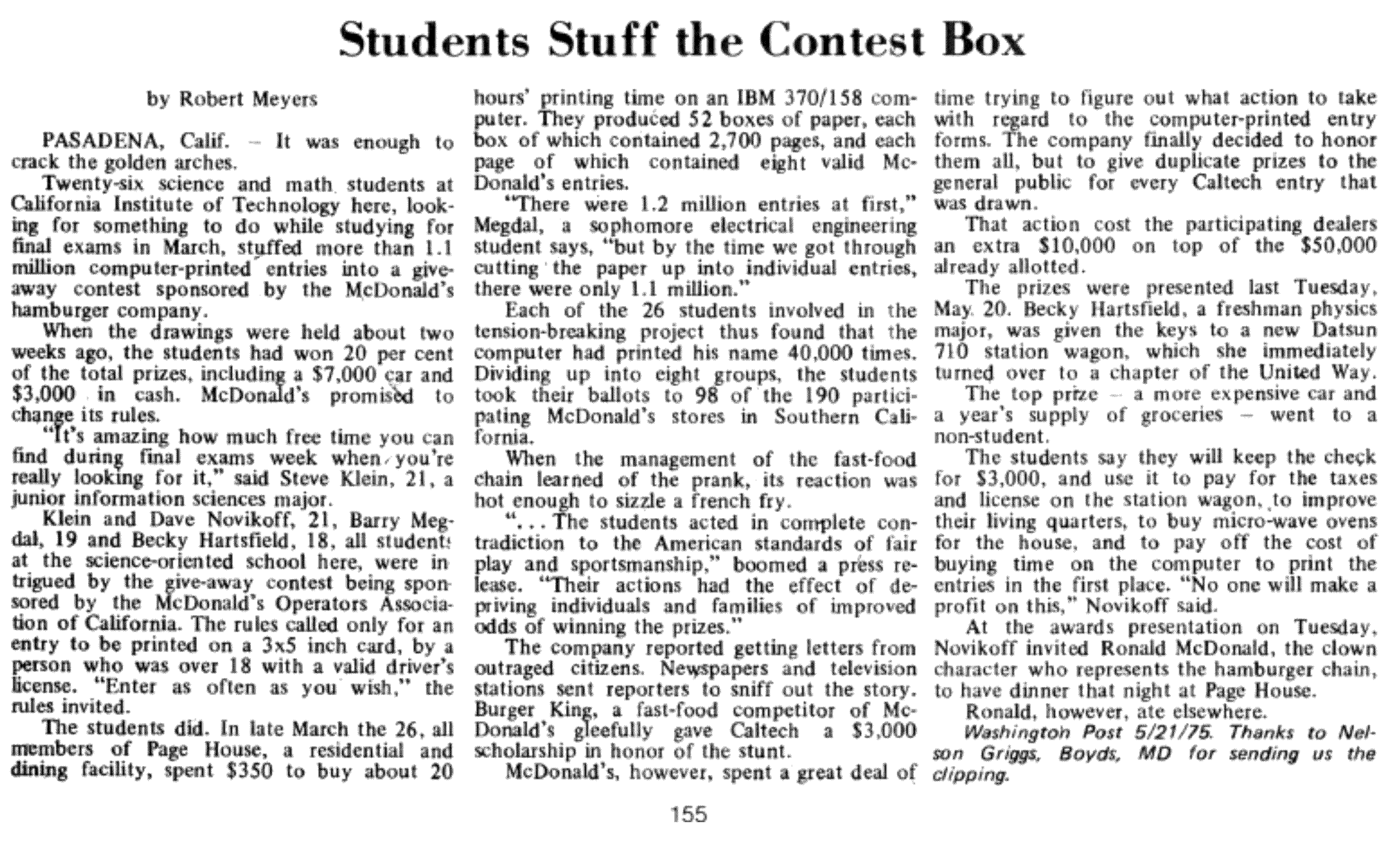Creative Computing and BASIC Computer Games in public domain
Among the most influential early home computer works were David Ahl’s BASIC Computer Games and More BASIC Computer Games. So many of the early video games on home computers seem directly inspired by text-based games that appeared in these works. From Star Trek to RobotWar and Lunar Lander to Slalom, the programs in these books would dominate the world of home computer BASIC for years after off-the-shelf home computers were introduced.
We were starved for BASIC programs in those days. Because Ahl’s books were already available they escaped the server rooms across the country into the wild. They were quickly published professionally, and besides the “generic” versions of Ahl’s books there were also special versions targeted to the home computers of the era, such as BASIC Computer Games TRS-80 Edition.
Ahl was also editor of Creative Computing the magazine. It was initially aimed at educational markets. Because it predated the home computer market, it was already available on the newsstand and in back issues, and occasionally even in libraries, for anyone who needed more information about the world of computers or who wanted BASIC computer programs to type in. It was a rare source of information about computers and computer programming once home computers became generally available.
Many of these works have generally been available in the shadow market of works that no one’s defending. But David Ahl has decided to explicitly return them to the public domain. This is awesome.
You can find most of them on the Internet Archive; sites such as Ira Goldklang’s TRS-80 Revived also have them for download now that it’s explicitly legal to do so.

Hunt the Wumpus is one of the very earliest computer games and was quickly adapted to home computers once they became available.
The interesting publications to me are the “best of” collections. These are what the editors thought were worth saving from the magazines. The first volume of The Best of Byte1 has reviews of the Z80, and the Cromemco TV Dazzler, for example. There are also articles on the basics of computers, how logic circuits work and how serial interfaces work.
But there were also important lessons. In his introduction to a biorhythm chart generator, Byte editor Carl T. Helmers, Jr., wrote
One danger of computer programming is the assumption that a logically correct program which executes without bombing out will necessarily produce meaningful results. — Carl T. Helmers, Jr. (Biorhythm for Computers)
Biorhythm generators were very popular in the day, probably because they were both simple and an interesting challenge, and probably also because they were a model that couldn’t really be falsified. This was one of the few programs reproduced in The Best of Byte, Volume 1. Trusting untrustworthy theories and data after they’ve been transformed into graphs is a problem that plagues us to this day.
Reality’s an untamed beast
That’s difficult to master,
But models are quite docile
And give you answers faster.So build yourself a model
To glorify your name.
Then get yourself a task force
And learn to play the game. — J.C.L. Guest (Decison-Making)

Vicious Vic, for the TRS-80 Color Computer, is clearly inspired by Chase in More BASIC Computer Games. It is more commonly known as RobotWar.
Byte was very different from Creative Computing. It was written for people who wanted their own computer and would build one if none were available. Creative Computing’s educational focus meant it was marketed mainly for people who had access to someone else’s computer. This meant it had more programs in it than hardware projects.
It also meant it was more focused on the academic paranoias of the day, such as the coming ice age. Could computers, asked an article in The Best of Creative Computing, Volume 1, and especially computer simulations, help us solve the “global cooling trends”?
Their graphs look a lot like biorhythms, with about the same science behind them. The problem may have literally turned on its head half a century later, but the solution of organizations like the 1970s Club of Rome remains the same: stop all sources of progress.
It was, as Simon S. Kuznets harshly noted, “a simplistic kind of conclusion—you have problems, and you solve them by stopping all sources of change.”
There are weird bits of pop-culture history hidden in the pages of the volume 1 best of, too. A gaming company called Flying Buffalo is profiled. This pre-D&D Flying Buffalo was focused on play-by-mail games. One article, by an eighth-grade student about their experience at Xerox PARC, focused on using Smalltalk in 1973. But they included pictures of the system they used, a system that looks almost but not entirely unlike the initial Macintosh interface, to paragraph Douglas Adams.
Even more fascinating to me: an article on a bunch of CalTech students who won 20% of the prizes in a McDonalds contest. “Enter as many times as you like”, so they did. It is, of course one of the many strange and wonderful CalTech stories used nearly verbatim in the surprisingly non-fictional Real Genius•.
The introduction to The Best of Creative Computing, Volume 2 is perhaps the most fascinating part of this second Creative Computing collection. It was written in January of 1977. Ahl clearly had no idea that three major non-kit home computers would be released by the end of the year. But he and the other Creative Computing contributors absolutely knew that home computers were coming. They saw how computer chips were getting cheaper, smaller, and less power-hungry. It was obvious to them that such chips would eventually spread not just to home computers but to non-computer appliances as well.
In a few years, everywhere you turn, a computer will be there to assist, to inform, or simply to play with.
And despite their not knowing when home computers would arrive, they knew very well what a world where “everywhere you turn, a computer will be there to assist, to inform, or simply to play with” meant for privacy.
One threat to privacy comes from the willingness of most people to provide information about themselves voluntarily.
On the gaming front, there’s a version of the famous Hunt the Wumpus game in this second collection. This was an extraordinarily influential game: almost an adventure, turn-based, a couple of monsters, one or two traps, even a puzzle of sorts to solve. I made a version of Hunt the Wumpus for the TRS-80 Color Computer and among old-school games this is a fun one.
The BASIC game collections are fun reminders of how far we’ve come in the world of gaming—and some of these games remain fun in their primitive state. But these three magazine collections provide an extraordinary glimpse into a culture that was about to find all their dreams come true, far sooner than they expected. They’re a reminder that the problems plaguing us today are not new—and in most cases, they’re less problems in search of a solution than solutions in search of a problem.
Which is probably not included under the release, since it was only edited by Ahl; he was not the publisher of Byte. It’s still freely available on the Internet Archive, however.
↑
downloads
- 101 BASIC Computer Games: David Ahl at Internet Archive Audio Archive
- “This is not the first collection of computer games and simulations nor will it by any means be the last.”
- BASIC Computer Games TRS-80 Edition Volume II: David Ahl at Internet Archive (ebook)
- “Hours of entertainment from 84 programmable games designed for use with the Radio Shack TRS-80.”
- The Best of Byte, Volume I: David Ahl and Carl T. Helmers, Jr. at Internet Archive (ebook)
- A fascinating look at the pre-home computer era. Selected articles from Byte Magazine’s first year, including hardware projects, software projects, and more.
- The Best of Creative Computing Volume 1: David Ahl at Internet Archive
- A complete copy of this 1976 volume of 1975 articles, including Hunt the Wumpus and an Atari profile.
- The Best of Creative Computing, Volume 2: David Ahl at Internet Archive (ebook)
-
 “No longer do we have to look to educational institutions being the only source of hands-on computer power. Indeed, it won’t be long before there is more computer power in the hands of people at home than in all the schools and colleges combined.”
“No longer do we have to look to educational institutions being the only source of hands-on computer power. Indeed, it won’t be long before there is more computer power in the hands of people at home than in all the schools and colleges combined.”
- Creative Computing Magazine archive
- “Full text of 35 issues” from the Classic Computer Magazine Archive.
- Creative Computing Part 2: Ira Goldklang at Ira Goldklang’s TRS-80 Revived
- “Books and magazines which were Creative Computing have also been made available for download.”
- More BASIC Computer Games: David Ahl at Internet Archive (ebook)
- “For the computer combines the possibility of fun, education, challenge, personalization, humor and—most important—interaction, in a way that no other medium can.”
computer history
- 1973: Hunt the Wumpus: Aaron A. Reed
- “Wumpus has been identified as one of the earliest ancestors of the text adventure, a form that would crystallize more completely with Adventure in the second half of the decade. Like the latter game, it has a map that must be explored, challenges to overcome, a memorable adversary, and the first hints of a transporting story.”
- Dave Ahl puts Work into Public Domain: Ira Goldklang at Ira Goldklang’s TRS-80 Revived
- “Dave Ahl has posted to his Facebook page that ‘This is a public notice that I am formally placing everything that I have written or edited into the Public Domain…’ I will be making all Creative Computing and Dave Ahl stuff available for download.”
- Hunt the Wumpus: Conditional code and include files in SuperBASIC
- Hunt the Wumpus can talk to you if you have a speech synthesizer.
- Real Genius•
- A movie about college kids that didn’t dumb down college to get its laughs. One of my favorite movies.
- Review: BASIC Computer Games: Jerry Stratton at Jerry@Goodreads
- “This is a variation on Ahl’s semi-anonymous 101 BASIC Computer Games from Digital Equipment Corporation, 1973 or so. That was a somewhat organic compilation: the back of the book included instructions on how to submit games to the book.”
- Review: More BASIC Computer Games: Jerry Stratton at Jerry@Goodreads
- “This collection was put together in 1979, two years after the introduction of the then big three computers… Like its predecessor’s, the programs in this book are designed around computers whose display is a printing terminal.”
- Review: The Best of Byte, Volume 1: Jerry Stratton at Jerry@Goodreads
- “The assumption throughout is that the reader either has [built their own computer], or has purchased a kit, or is about to. One of the articles evokes a very proto-cyberpunk image of salvaging old computers for parts for your own build.”
- Review: The Best of Creative Computing, Volume 1: Jerry Stratton at Jerry@Goodreads
- “It also highlights the problems with using computers as assistants in teaching: they only know what we know, and they tend to amplify our own ignorance.”
- Review: The Best of Creative Computing, Volume 2: Jerry Stratton at Jerry@Goodreads
- “Creative Computing started publishing before there were any home computers to publish for. Their market appears to have been people with access to college mainframes… they didn’t know how fast the computer world was going to change, [but] absolutely knew that they were at the pre-dawn of the home/hobbyist computer user.”
More computer history
- Hobby Computer Handbook: From 1979 to 1981
- Hobby Computer Handbook lived for four issues, from 1979 to 1981. Back in 1979 and 1980, I bought the middle two issues. I’ve recently had the opportunity to buy and read the bookend issues.
- Hobby Computer Handbook
- Hobby Computer Handbook was a short-lived relic of the early home computer era, an annual (or so) publication of Elementary Electronics.
- 8 (bit) Days of Christmas: Day 11 (O Christmas Tree)
- Day 11 of the 8 (bit) days of Christmas is the graphic accompaniment to “O Tannenbaum” from Robert T. Rogers “Holly Jolly Holidays”, from December 1984.
- 8 (bit) Days of Christmas: Day 100 (Hearth)
- Lower resolution graphics were more appropriate for animation, because you could page through up to eight screens like a flip book. This is Eugene Vasconi’s Holiday Hearth from December 1986.
- 8 (bit) Days of Christmas: Day 101 (Rudolph)
- An early form of musical ebook, without scenes illustrating the progress of the song—in this case, Rudolph the Red-Nosed Reindeer. Along with the secret world of POKE.
- Six more pages with the topic computer history, and other related pages
More retro computer games
- Reversi in SuperBASIC on the Color Computer
- One of the ubiquitous games of the early computer era was reversi. Very simple rules, very simple board, very complex play. It’s easy to see why it was so popular.



